AI Employee ROI: Maximizing Value for Small Businesses

Lawrence Liu
8/30/2024

AI Employee ROI: Calculating Real Value for Small Businesses
1. Introduction: The AI Revolution for Small Businesses
In today's rapidly evolving business environment, small businesses are facing unprecedented opportunities and challenges. With technological advancements, especially the rapid development of artificial intelligence (AI), a silent revolution is quietly unfolding in small businesses. At the core of this revolution is the introduction of AI employees.
Imagine having an employee who works tirelessly, around the clock, and is capable of continuous learning and improvement. This is no longer a plot from science fiction, but has become a reality. AI employees are changing the way small businesses operate, providing unprecedented efficiency and insights.
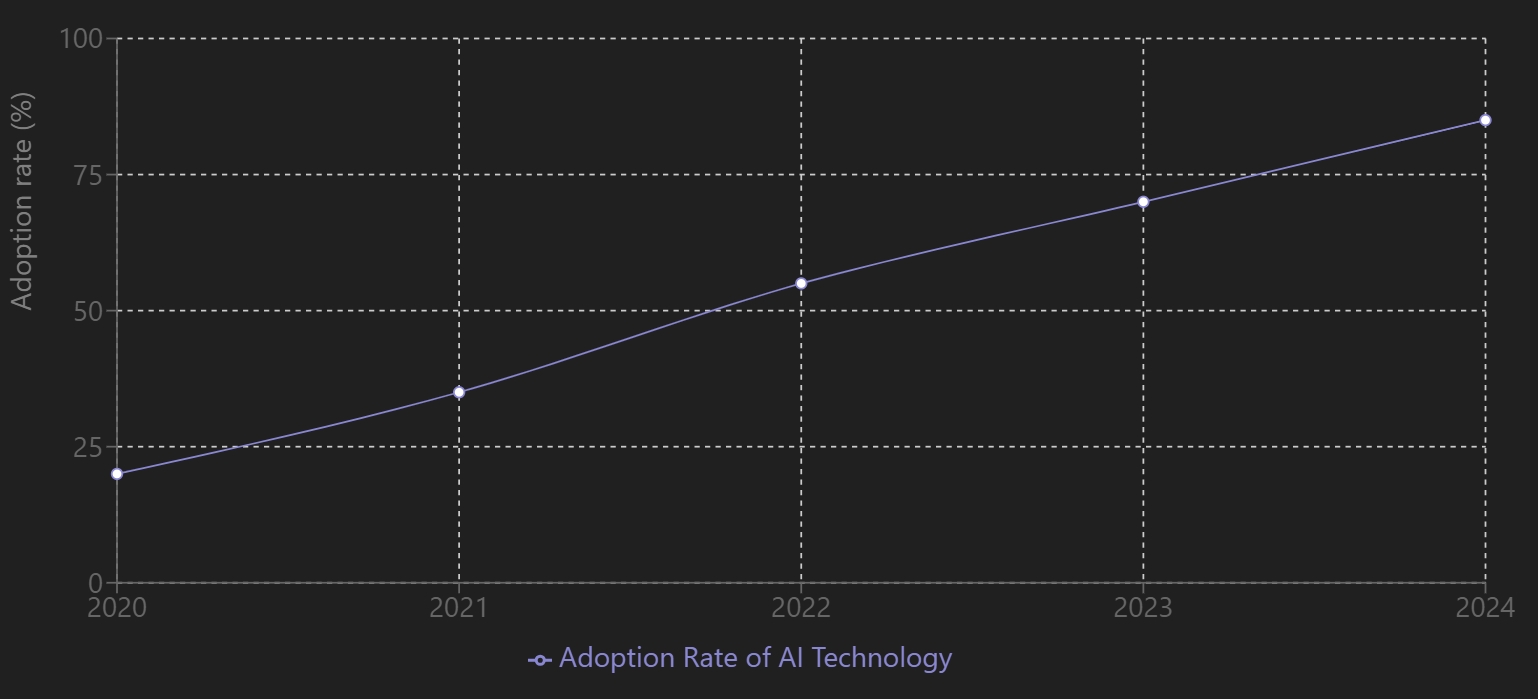
According to the latest research, it is expected that by 2025, over 60% of small businesses will adopt AI technology in some form. This trend is not just following in the footsteps of large enterprises, but an inevitable choice for small businesses to maintain an edge in a competitive market.
However, for many small business owners, introducing AI employees seems like an unattainable dream. They might ask: "Does my business really need AI employees?" "Is investing in AI employees worth it?" "How do I calculate the return on investment for this?"
In this article, we will delve deep into these questions, analyze the real value of AI employee investments for you, help you understand how AI creates value for small businesses, and how to calculate and maximize the return on investment (ROI) of AI employees.
Let's unveil the mysterious veil of AI employees together and explore the infinite possibilities of this AI revolution for small businesses.
This is the second article in our AI Employee series. View the full series:
- Small Teams, Big Impact: Leveraging AI Employees to Drive Startup Growth
- AI Employee ROI: Calculating Real Value for Small Businesses (This Article)
2. Analyzing AI Employee Investment
Investing in AI employees may be a new field for many small businesses. To fully understand this investment, we need to carefully consider its cost structure and potential benefits.
2.1 Initial Costs vs Long-term Benefits
Unlike traditional employees, AI employees have a unique cost structure. The initial investment may seem high, but long-term benefits often far exceed expectations.
Initial costs typically include:
- Purchase or subscription fees for AI systems
- Integration and customization costs
- Employee training costs
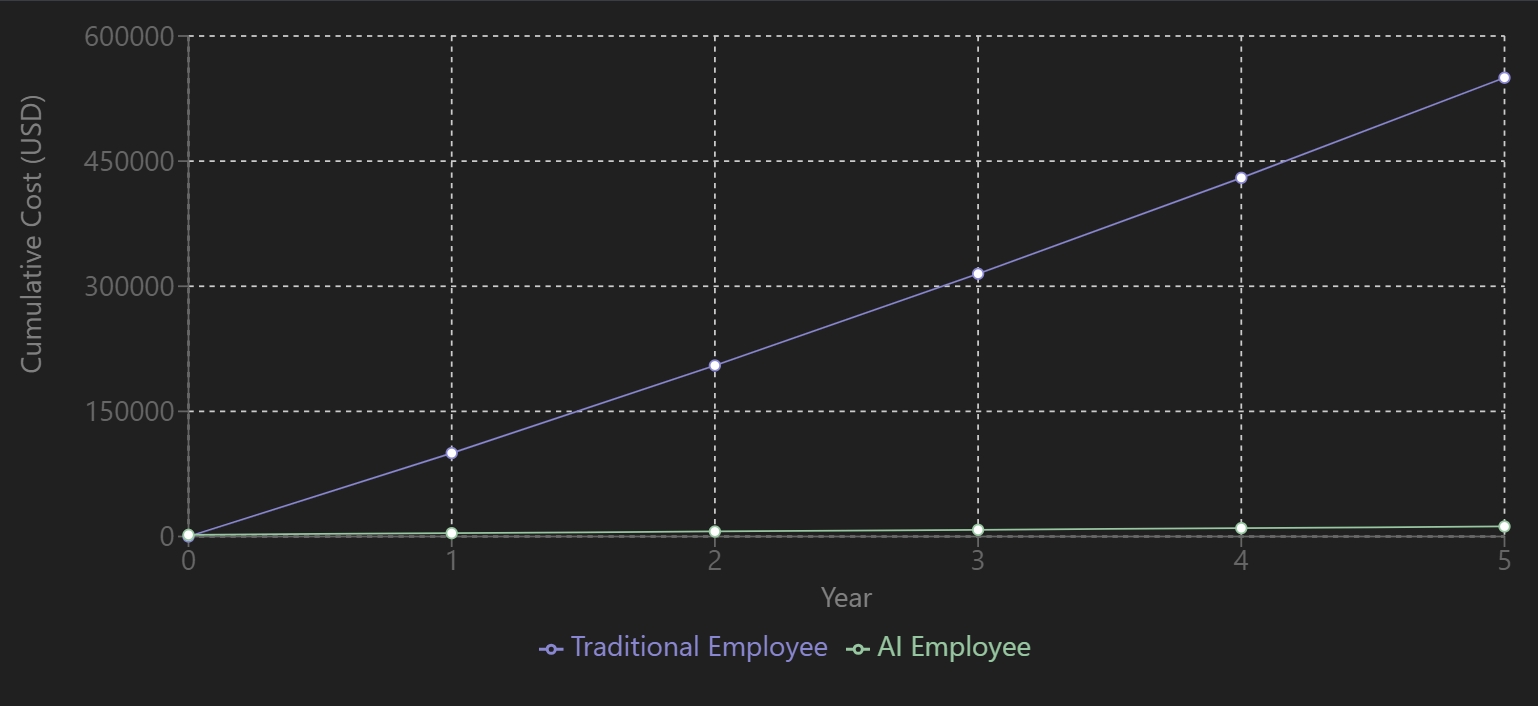
Long-term benefits include:
- Continuous productivity improvements
- Significant reduction in operating costs
- Substantial improvement in service quality
- Enhancement in decision-making quality
Research shows that despite higher upfront investments, most businesses achieve a return on investment within 12-18 months of adopting AI employees. This return grows exponentially over time.
2.2 Flexible Pricing Models
AI employee solution providers usually offer various flexible pricing models to meet the needs of businesses of different scales:
- Subscription model: Pay a fixed fee monthly or annually
- Pay-per-use: Pay based on actual usage
- Hybrid model: Basic subscription plus excess usage fees
This flexibility allows small businesses to choose the most suitable plan based on their needs and budget, effectively controlling costs.
2.3 Implicit Cost Considerations
When calculating AI employee investments, some implicit costs also need to be considered:
- Learning curve costs: Time for employees to adapt to the new system
- Data security and privacy protection costs
- System maintenance and update costs
- Potential risks of technology dependence
However, these implicit costs are often offset by the efficiency improvements and new opportunities brought by AI employees. For example, although there is a learning curve, AI systems usually quickly increase overall employee productivity.
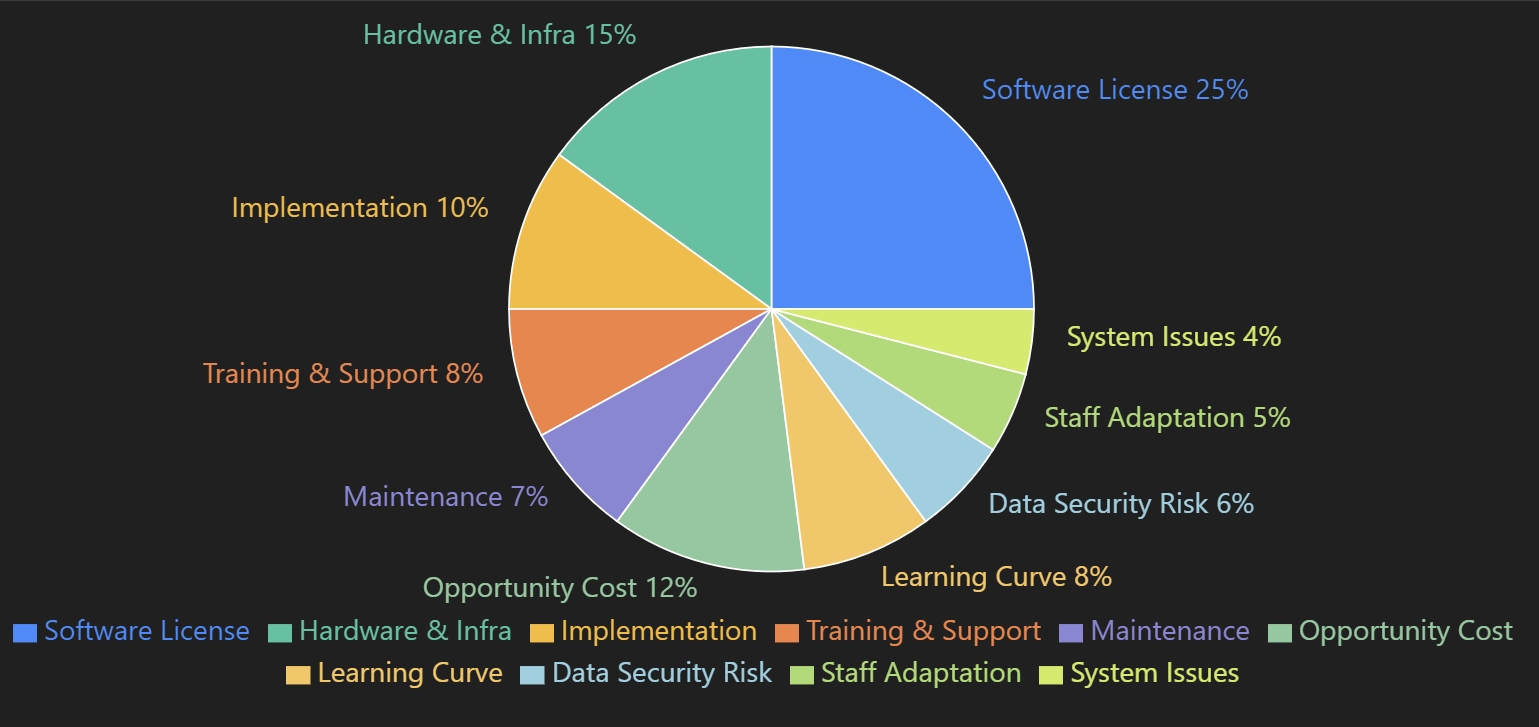
This pie chart shows the possible composition of AI employee investment costs, including explicit and implicit costs. Here's an explanation of the chart:
Explicit Costs
- Software licenses and subscription fees: The largest proportion (25%), reflecting the core investment in AI technology.
- Hardware and infrastructure costs: (15%) is the second largest explicit expenditure, including necessary computing resources.
- Implementation and integration fees: (10%) represent the cost of integrating AI systems into existing workflows.
- Training and support: (8%) and maintenance and updates (7%) ensure the continuous operation and efficiency of the system.
Implicit Costs
- Opportunity cost: (12%) is the largest implicit cost, reflecting the potential loss of investing in AI rather than other areas.
- Learning curve impact: (8%) represents the possible temporary decrease in productivity during the adaptation to new technology.
- Data security risks: (6%), employee adaptation costs (5%), and potential system issues (4%) are all important implicit costs to consider.
Overall, although investing in AI employees requires careful consideration of various factors, for most small businesses, the long-term benefits usually far outweigh the initial investment and potential implicit costs.
3. How AI Employees Create Value for Small Businesses
AI employees are not just a technology investment, but a strategic tool for small businesses to enhance their competitiveness. Let's discuss in detail how AI employees create substantial value for small businesses in multiple aspects.
Here's an explanation of each value point:
- Productivity Improvement: AI can automate many tasks, thereby increasing the overall productivity of small businesses. For example, 42% of small business owners say they use AI to increase productivity.
- Cost Reduction: Through automation and process optimization, AI can help small businesses reduce operating costs. Research shows that small businesses using AI can significantly reduce labor costs and operating expenses.
- Customer Service Enhancement: AI-driven chatbots and customer service tools can provide 24/7 support, improving customer satisfaction. About 25% of small businesses use AI to improve customer service.
- Data Analysis Improvement: AI can help small businesses better understand and utilize their data, making more informed decisions. About 30% of small businesses use AI for data analysis and insights.
- Precise Marketing: AI can help small businesses better understand their target audience and provide personalized marketing strategies. About 23% of small businesses use AI to optimize their marketing efforts.
- Accelerated Innovation: AI can help small businesses develop new products and services faster, maintaining a competitive edge. Research shows that small businesses using AI have an advantage in innovation compared to non-AI users.
This chart visually demonstrates how AI has become a strategic tool for small businesses to enhance their competitiveness.
3.1 Efficiency Multiplier: Improving Productivity
AI employees can significantly improve the overall productivity of small businesses:
- Automating repetitive tasks: AI can take over repetitive work such as data entry and report generation, freeing up human employees' time and energy.
- Rapid information processing: AI can analyze large amounts of data in seconds, providing instant insights.
- Multi-tasking: A single AI system can handle multiple tasks simultaneously, equivalent to the workload of multiple human employees.
Long-term productivity improvement: The chart shows that over a 10-year time span, the introduction of AI employees could lead to an 18% increase in productivity. This is a significant growth, far exceeding the productivity improvements typically brought by traditional technologies.
3.2 Cost Optimization: Beyond Traditional Human Resources
Compared to traditional employees, AI employees have significant advantages in terms of cost:
- No need to pay salaries, benefits, or overtime
- Don't take sick leave or vacation
- Training costs significantly decrease over time
- Can be quickly scaled up or down without considering recruitment or layoff costs
3.3 Quality Improvement: Consistently High Standard of Service
AI employees can provide consistently high-quality service:
- Work quality is not affected by fatigue or emotional fluctuations
- Strictly follow preset best practices and standards
- Continuous learning and optimization, service quality improves over time
- Reduce human errors, improve accuracy
Customer satisfaction surveys show that businesses adopting AI customer service have an average 30% increase in customer satisfaction.
3.4 Insight Engine: Data-Driven Decision Support
AI employees can extract valuable insights from massive data:
- Real-time market trend analysis
- Customer behavior prediction
- Sales forecasting and inventory optimization
- Risk assessment and early warning
3.5 Non-Stop Operation: 24/7 Working Capability
The round-the-clock working capability of AI employees brings new opportunities for small businesses:
- Provide 24/7 customer service, meeting the needs of global customers
- Achieve continuous operation of business processes, improving efficiency
- Monitor systems and handle emergencies, reducing downtime
Through these methods, AI employees are reshaping the operational models of small businesses, helping them stand out in increasingly fierce market competition. Whether it's improving efficiency, reducing costs, improving service quality, or providing in-depth insights, AI employees are creating unprecedented value for small businesses.
In the next section, we will explore which positions are best suited for implementing AI employees first, and how to start this transformation process.
4. Best Entry Points: Which Positions Are Best Suited for Implementing AI Employees First
When starting the journey of AI employees, choosing the right entry point is crucial. Some positions are naturally more suitable for AI, quickly demonstrating value and laying the foundation for further expansion of AI applications. Let's explore several of the best starting positions.
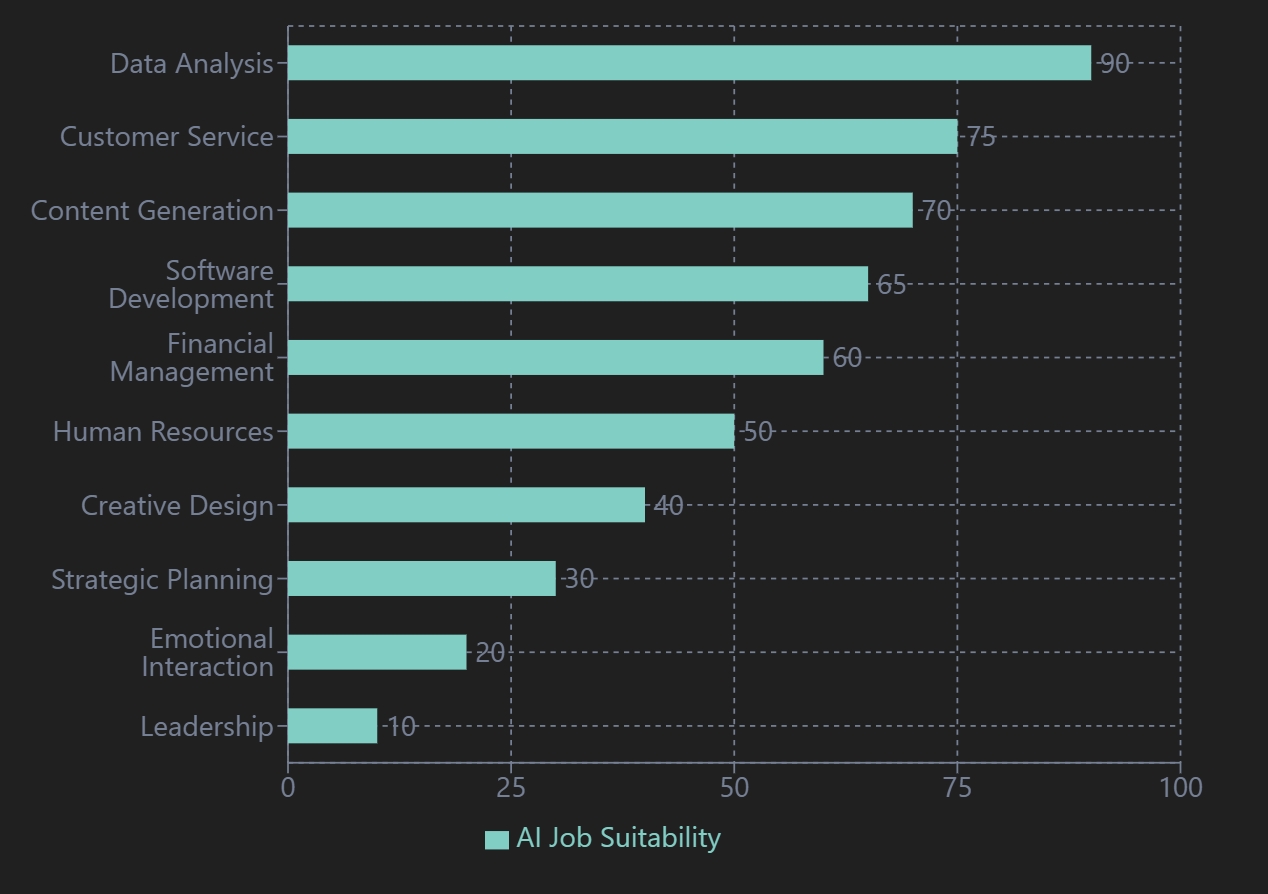
This chart shows the degree of suitability for AI employees in different positions, based on a score of 0-100. Let me explain this chart for you:
- Data Analysis (90 points): AI excels in processing and analyzing large amounts of data, making it very suitable for this type of work.
- Customer Service (75 points): With advancements in natural language processing technology, AI can handle many common customer inquiries, but may still require human intervention for complex or emotional issues.
- Content Generation (70 points): AI has strong capabilities in generating text, reports, etc., but may lack human creativity and emotional depth.
- Program Development (65 points): AI can assist with coding and debugging, but complex system design and innovation still require human developers.
- Financial Management (60 points): AI can handle data analysis and predictions, but complex financial decisions still require human expertise.
- Human Resources (50 points): AI can help screen resumes and handle routine inquiries, but human involvement is still needed in employee relations and culture building.
- Creative Design (40 points): Although AI can generate some creative content, true innovation and artistic creation still mainly rely on humans.
- Strategic Decision-making (30 points): AI can provide data support, but complex strategic decisions still require human judgment and insight.
- Emotional Interaction (20 points): AI's performance is still limited in positions requiring deep emotional understanding and empathy.
- Leadership and Management (10 points): Leadership, team motivation, and complex interpersonal interactions remain human strengths.
This chart shows that AI performs well in handling data, repetitive tasks, and information retrieval, but humans still have an advantage in positions requiring high creativity, emotional intelligence, and complex decision-making. It's important to note that as technology continues to advance, these scores may change over time.
4.1 Marketing and Content Creation: AI's Natural Advantage
Marketing and content creation are areas where AI excels:

In discussing how AI employees are radically changing the marketing field, this chart vividly demonstrates its powerful impact. Let's interpret together what this chart reveals about marketing innovation.
At the core of the chart is the adoption of AI marketing employees, a seemingly simple decision that is actually the beginning of a transformation. It directly affects four key areas:
- Improving employee productivity,
- Optimizing marketing strategies,
- Personalizing marketing content, and
- Enhancing data analysis.
Imagine when AI employees take over tedious tasks like data processing and report generation, your team can focus on creativity and strategy. AI not only formulates precise marketing strategies but also tailors content for each customer while providing in-depth data analysis and insights.
The synergistic effect of these four areas ultimately converges to a key outcome: significantly improving marketing ROI. But what's more exciting is the shift in thinking shown at the bottom—from focusing on the return on single ad spend (ROAS) to looking at the overall return on marketing investment (ROI).
This shift means we are no longer limited to short-term advertising effects, but are pursuing sustainable long-term growth. By introducing AI employees, we not only improve marketing efficiency but also redefine the essence of marketing.
In this new era driven by AI, let's explore together the infinite possibilities brought by AI marketing employees and jointly welcome a bright future in the marketing field.
4.2 Customer Service: Improving Response Speed and Satisfaction
AI applications in the customer service field are revolutionizing user experience:
- Intelligent chatbots: Handle customer inquiries 24/7, greatly improving response speed
- Sentiment analysis: Identify customer emotions, transfer to human customer service when appropriate
- Automatic classification and routing: Accurately assign customer issues to the most suitable processing department
- Knowledge base management: Continuous learning and updating, providing the latest and most accurate information
4.3 Data Analysis: Extracting Insights from the Ocean of Information
In the data-driven business world, AI is the winning formula for small businesses:
- Predictive analytics: Predict future trends based on historical data
- Anomaly detection: Identify abnormal patterns in data, detecting problems early
- Automatic report generation: Convert complex data into easy-to-understand visual reports
- Real-time analysis: Provide instant business insights, supporting quick decision-making
4.4 Administrative Assistant: Improving Daily Operational Efficiency
AI administrative assistants can greatly enhance the operational efficiency of small businesses:
- Schedule management: Intelligently arrange meetings, avoiding time conflicts
- Email management: Categorization, priority sorting, and even drafting replies
- Document management: Automatically organize and retrieve documents
- Workflow automation: Simplify daily processes such as reimbursement and leave requests
4.5 Case Focus: How AI Marketing Experts Revolutionize Small Business Marketing
Let's take a deep look at how Aimee, our AI marketing expert, radically changes the marketing strategies of small businesses:
- Comprehensive market analysis: Aimee can analyze market trends, competitor dynamics, and customer behavior in real-time.
- Content creation: From blog posts to social media posts, Aimee can generate engaging, SEO-optimized content.
- Personalized marketing: Based on customer data, Aimee provides tailored marketing messages for each customer.
- Marketing campaign management: Aimee can automatically plan, execute, and optimize cross-channel marketing campaigns.
- Performance analysis: Track marketing metrics in real-time, providing in-depth ROI analysis and optimization suggestions.
Through Aimee, small businesses can achieve enterprise-level marketing effects without a large marketing team and budget.
5. ROI Analysis: Quantifying the Value of AI Employees
Understanding and quantifying the return on investment (ROI) of AI employees is crucial for small businesses. Let's delve into how to accurately calculate the ROI of AI employees.
5.1 Comprehensive ROI Calculation Method
Calculating the ROI of AI employees requires considering multiple factors:
ROI = (Benefits - Investment) / Investment * 100%
Benefits include:
- Value brought by productivity improvements
- Cost savings (such as labor costs, operating costs)
- Increased revenue (such as through improved customer service or marketing effectiveness)
- Value brought by error reduction
Investment includes:
- Initial purchase/subscription costs
- Implementation and integration costs
- Training costs
- Operation and maintenance costs
Our AI Employee ROI Calculator is under development. Once completed, we will update the link here, and you can use this tool for related calculations.
5.2 Key Considerations and Variables
When calculating ROI, the following key factors need to be considered:
- Time frame: AI investments usually take some time to show their full value.
- Direct vs indirect benefits: In addition to direct cost savings, indirect benefits such as improved decision quality should also be considered.
- Scale effect: As the scope of use expands, the ROI of AI typically increases.
- Industry characteristics: The effectiveness of AI applications may vary across different industries.
- Employee adaptability: Consider the time for employees to learn and adapt to AI systems.
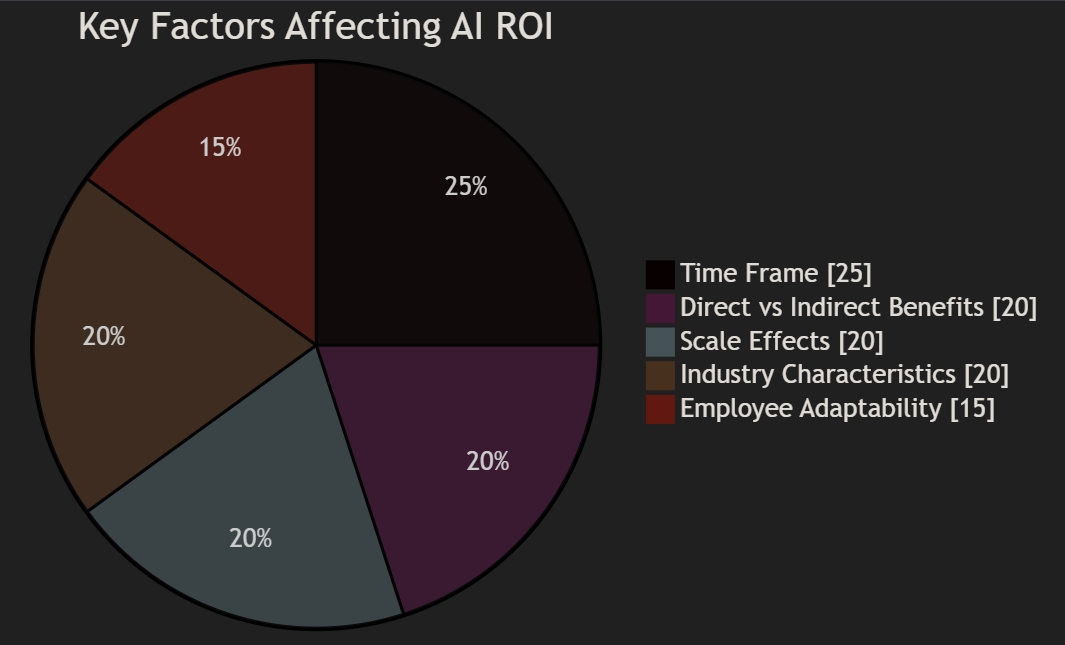
This pie chart shows five key factors affecting AI ROI and their relative weights, explained as follows:
- Time frame (25%): This is the most important factor, as AI investments usually take time to show their full value. McKinsey's research suggests that the economic potential of generative AI may take some time to fully realize, emphasizing the importance of considering long-term returns. [1]
- Direct vs indirect benefits (20%): In addition to direct cost savings, AI can bring indirect benefits such as improved decision quality. In the retail and consumer goods industry, generative AI supports key value drivers, including both direct and indirect benefits. [1]
- Scale effect (20%): As the scope of AI use expands, its ROI typically increases. This is particularly important when implementing AI in small and medium-sized enterprises (SMEs), as the benefits of AI may grow exponentially as the business grows. [2]
- Industry characteristics (20%): The effectiveness of AI applications may vary across different industries. For example, in the field of predictive maintenance, the ROI of AI is significantly affected by industry-specific factors such as equipment type and maintenance strategy. [3]
- Employee adaptability (15%): Considering the time for employees to learn and adapt to AI systems is important, but has a relatively lower weight. This is because employees typically adapt to new technologies over time, and initial adaptation costs are offset by long-term benefits. However, digital and social media marketing research emphasizes the importance of human resource management in AI applications. [4]
6. Strategies to Maximize Return on Investment in AI Employees
After understanding the potential ROI of AI employees, the next question is: How can you ensure that your business maximizes the return on this investment? Here are some key strategies:
6.1 Precise Matching: Choosing the Most Suitable AI Solution
Choosing the right AI solution is key to success:
- Clarify needs: Carefully assess your business pain points and goals
- Industry relevance: Choose solutions specifically designed or customizable for your industry
- Scalability: Ensure the solution can scale as your business grows
- Integration capability: Choose solutions that can seamlessly integrate with your existing systems
- Supplier reputation: Research the supplier's track record and customer reviews
6.2 Seamless Integration: Efficient Implementation and Integration Methods
Successful AI implementation requires careful planning and execution:
- Develop a clear implementation roadmap
- Conduct comprehensive system compatibility testing
- Implement in phases, starting with small-scale pilots
- Provide adequate employee training to ensure a smooth transition
- Establish feedback mechanisms to address issues promptly
6.3 Continuous Evolution: The Importance of Optimization and Updates
AI technology is evolving rapidly, and continuous optimization is key to maintaining competitiveness:
- Regularly evaluate performance: Set KPIs and regularly assess the performance of AI employees
- Continuous learning: Utilize machine learning capabilities to let AI continuously learn from new data
- Timely updates: Keep up with the latest developments in AI technology, upgrade systems in a timely manner
- Collect feedback: Value feedback from employees and customers, continuously improve AI systems
- Expand application scope: As familiarity increases, gradually expand the application of AI in the enterprise
The following is an illustration of the impact of continuous optimization on AI employee ROI, based on industry insights
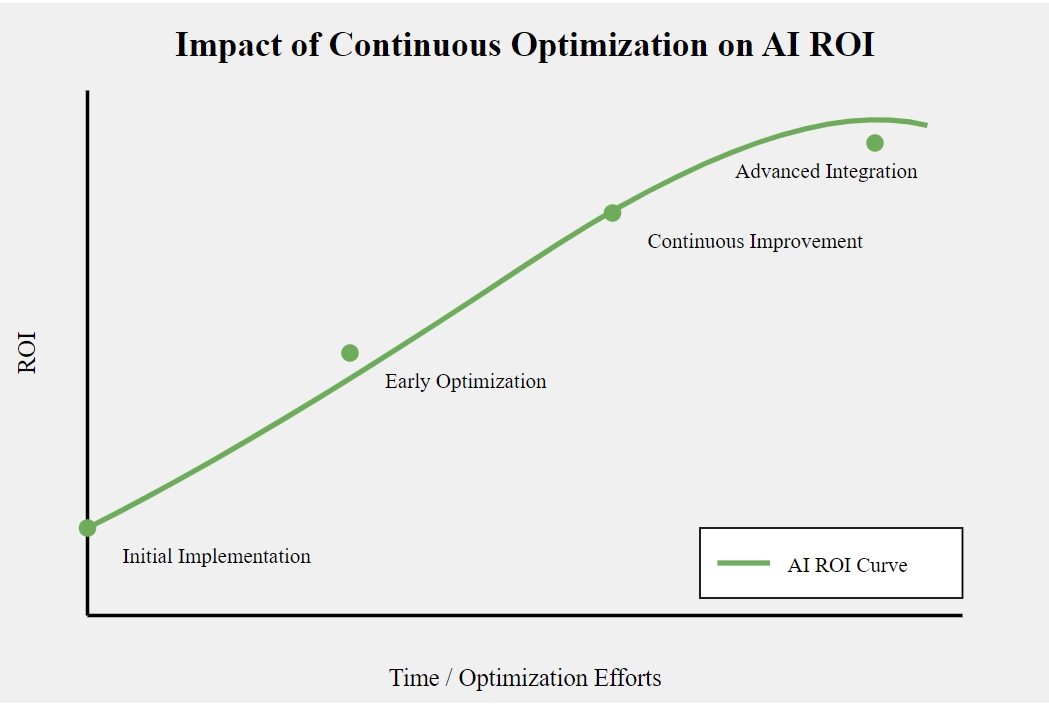
Related information sources are:
- McKinsey's report points out that the application of AI and generative AI has huge potential in marketing and sales fields, and data-driven recommendations can ensure maximum return on investment. [1]
- A study conducted by Forrester Consulting shows that using Cognite Data Fusion® (an industrial AI platform) can achieve a 400% ROI. This indicates that continuous optimization and leveraging AI can bring significant returns on investment. [2]
- IBM Turbonomic mentions that automation and continuous cloud optimization can improve efficiency and enhance ROI in hybrid cloud and multi-cloud environments through data-driven decision-making. [3]
- In AI maturity assessment, fully integrating AI into marketing processes and conducting continuous optimization can have a significant impact on business outcomes. [4]
Through these strategies, small businesses can ensure that their AI employee investments always remain efficient and relevant, continuously improving ROI. Remember, introducing AI employees is not just a one-time technology upgrade, but an ongoing optimization process that requires businesses to maintain an open and adaptive mindset.
In the next section, we will explore the challenges that may be faced when implementing AI employees, and how to effectively address these challenges to ensure a smooth and successful AI employee journey.
7. From Concept to Practice: Step-by-Step Guide to Implementing AI Employees
Transforming AI employees from concept to practice is a systematic process. Here's a detailed step-by-step guide to help you smoothly implement AI employees.
-
Needs Assessment (2-4 weeks)
- Identify business pain points and opportunities
- Define specific goals and expected outcomes
- Evaluate existing systems and processes
-
Solution Research (3-6 weeks)
- Explore AI solutions in the market
- Conduct preliminary communication with potential suppliers
- Evaluate the match between solutions and enterprise needs
-
Selection and Procurement (2-4 weeks)
- Conduct detailed supplier comparisons
- Negotiate contract terms
- Determine budget and resource allocation
-
Planning and Preparation (4-6 weeks)
- Develop a detailed implementation plan
- Form a project team
- Prepare necessary data and infrastructure
-
Pilot Implementation (6-8 weeks)
- Deploy AI systems on a small scale
- Conduct initial testing and adjustments
- Collect early user feedback
-
Full Deployment (8-12 weeks)
- Gradually expand the application scope of AI systems
- Conduct system integration and data migration
- Provide comprehensive user training
-
Monitoring and Optimization (Ongoing)
- Continuously monitor system performance
- Collect and analyze user feedback
- Regularly update and optimize the system
Implementation Checklist:
- ✅ Clearly define project objectives and success criteria
- ✅ Obtain senior management support
- ✅ Choose suitable AI solutions
- ✅ Develop a detailed implementation plan and timeline
- ✅ Form a cross-departmental project team
- ✅ Prepare necessary data and infrastructure
- ✅ Conduct pilot testing and collect feedback
- ✅ Provide comprehensive employee training
- ✅ Develop a change management strategy
- ✅ Establish performance monitoring mechanisms
- ✅ Plan for regular evaluation and optimization processes
By following this step-by-step guide and checklist, you can systematically implement AI employees, minimizing risks and ensuring a smooth transition. Remember, implementing AI is not an overnight process; it requires patience and continuous effort.
8. Breaking Doubts: Addressing Common Concerns About Adopting AI Employees
Although AI employees can bring tremendous value, many small businesses still have doubts about them. Let's look at some common concerns and explain how these concerns might be misunderstood.
- Cost concerns
- Technical complexity
- Data security
- Job replacement
- Loss of human touch
Myths and Reality
-
Myth: AI is too expensive for small businesses to afford
Reality: Many AI solutions offer flexible pricing models, with low initial investments possible
-
Myth: Implementing AI requires a high level of technical expertise
Reality: Modern AI solutions are often user-friendly, with vendors providing comprehensive support
-
Myth: AI will threaten data security
Reality: AI systems usually have strong security measures, potentially safer than manual operations
-
Myth: AI will replace human jobs
Reality: AI often enhances rather than replaces human capabilities, creating new job opportunities
-
Myth: AI lacks human touch and will affect customer relationships
Reality: AI can provide personalized services, working best when used in conjunction with human employees
Understanding the truth behind these common concerns helps small businesses make more informed decisions, overcoming fears and misconceptions about AI.
9. Looking Ahead: The Joint Growth of AI Employees and Small Businesses
As AI technology continues to advance, AI employees will play an increasingly important role in the future development of small businesses. Let's look ahead to the prospects for the joint growth of AI and small businesses in the next 5-10 years.
- Deep collaboration: AI employees will be more deeply integrated into teams, seamlessly collaborating with human employees.
- Personalized AI: Every business will have AI employees customized according to their unique needs.
- Decision-making partners: AI will become an important participant in high-level decision-making, providing data support and predictive analysis.
- Innovation catalysts: AI will help small businesses rapidly prototype and test new ideas.
- Comprehensive business support: From finance to human resources, AI will cover more business areas.
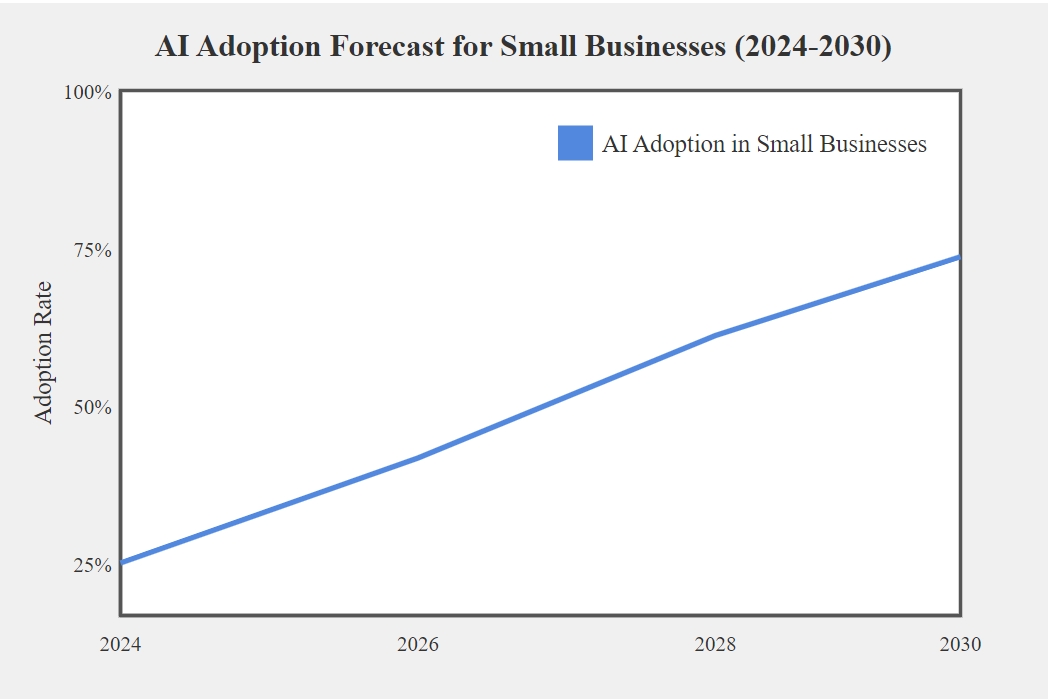
Predictions show that by 2030:
- 80% of small businesses will use AI in core business
- AI will help small businesses improve productivity by over 50%
- 70% of customer service interactions will be handled by AI
- AI-driven decision support will become standard practice
This future outlook paints a picture of AI employees harmoniously coexisting with human employees and jointly driving the growth of small businesses. Businesses that embrace this trend will have a head start in future competition.
10. Conclusion: Seizing the Opportunities of the AI Revolution
We have deeply explored how AI employees create value for small businesses, from ROI analysis to implementation guides, to future outlook. Now, it's time to summarize the key insights and opportunities brought by this AI revolution.
"AI is not just the patent of large enterprises; it is reshaping the competitive landscape of small businesses."
"After adopting AI employees, average productivity increases by 40-60%, and customer satisfaction improves by 30%."
"By 2030, 80% of small businesses will use AI in core business."
AI employees represent a huge opportunity for small businesses. They can:
- Significantly improve productivity and efficiency
- Reduce operating costs
- Provide data-driven insights
- Improve customer experience
- Enhance the enterprise's innovation capability
However, seizing this opportunity requires action. Small businesses need to:
- Maintain an open and adaptive mindset
- Actively explore AI applications in their own business
- Develop a clear AI strategy
- Invest in suitable AI solutions
- Continuously learn and optimize
Remember, in this AI revolution, opportunities favor prepared businesses. Now is the best time for small businesses to use AI to enhance their competitiveness.
11. Call to Action: Join the AI-Driven Future
Having read this far, you now understand the enormous potential of AI employees for small businesses. Now, it's time to take action and start your AI journey.
Extended Reading
Have you started your AI employee journey? Review our series' first article to understand how AI employees drive startup growth:
Early Access Offer
Now, you have the opportunity to lock in a super value offer for our AI employee system.
Book now for just $19.9, and get a permanent 50% discount on the subscription price after the system's official release.
Don't miss this opportunity to participate in the AI-driven efficiency revolution. Join us in exploring how AI changes the way we work!
Join Our Community
We sincerely invite you to join our early adopter community. Here, you can:
- Exchange ideas with other cutting-edge technology enthusiasts and innovators
- Get the latest updates on the development of the AI employee system
- Directly influence the direction of system feature development
- Participate in exclusive beta testing and feedback activities
Join the community and become part of shaping the AI-driven future of work! Let's work together to create innovative work environments and drive innovation and development for small businesses and individual developers.
Related Posts

AI-Driven Personalized Marketing: Redefining the New Paradigm of Customer Experience
Dive deep into how AI marketing employees are revolutionizing personalized marketing strategies. From precise customer profile construction to dynamic content generation, understand how AI creates unprecedented personalized customer experiences.

AI Marketing Employee: A New Paradigm for Data-Driven Decision Making
Explore how AI marketing employees are revolutionizing data processing and analysis. Learn how this groundbreaking technology provides real-time insights, optimizes decision-making processes, and drives precision in marketing strategies.
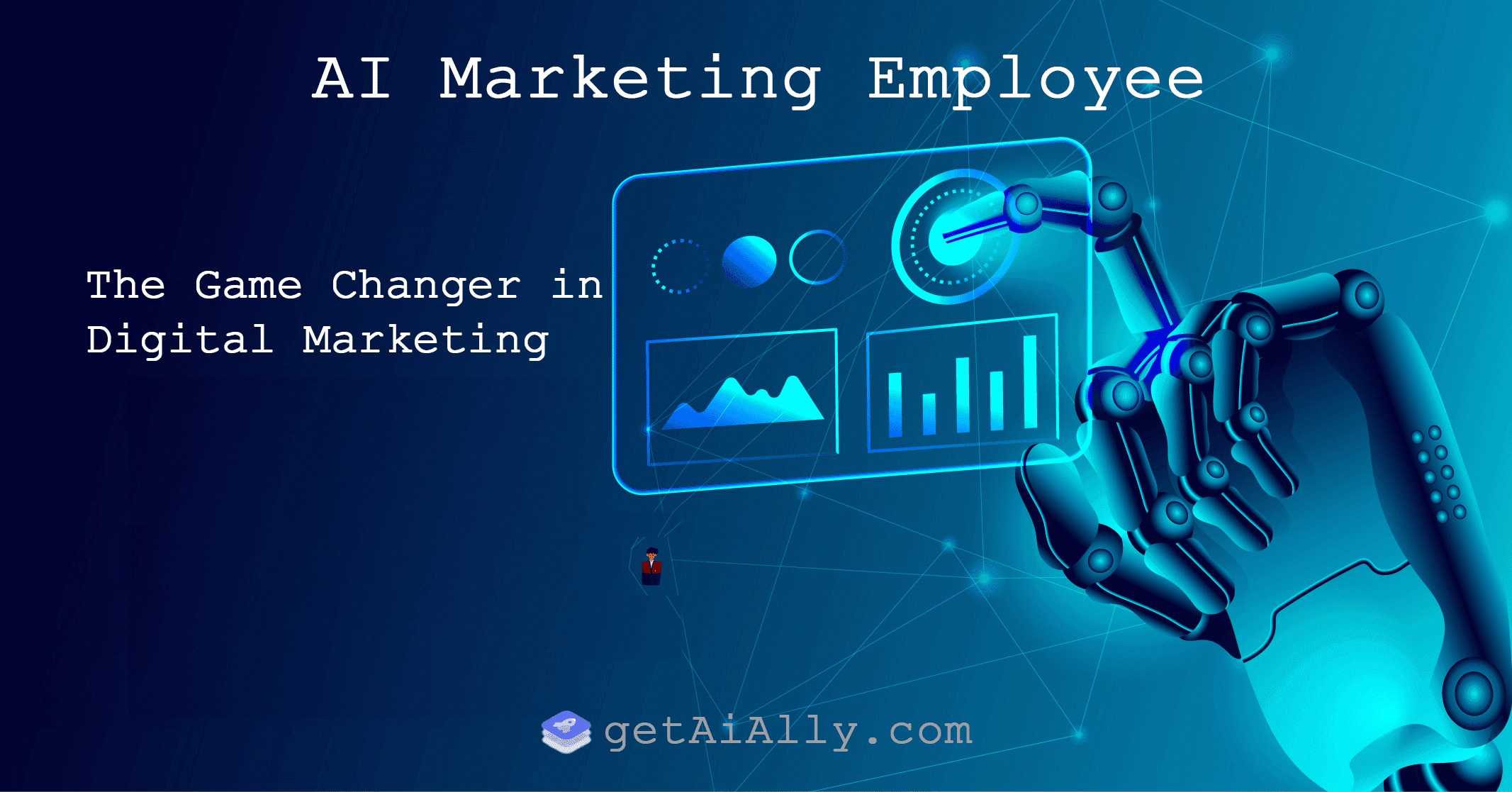
AI Marketing Employee: The Game Changer in Digital Marketing
Explore how AI marketing employees are revolutionizing the digital marketing landscape. Learn how this groundbreaking technology enhances efficiency, precision, and creates unprecedented value for brands.


